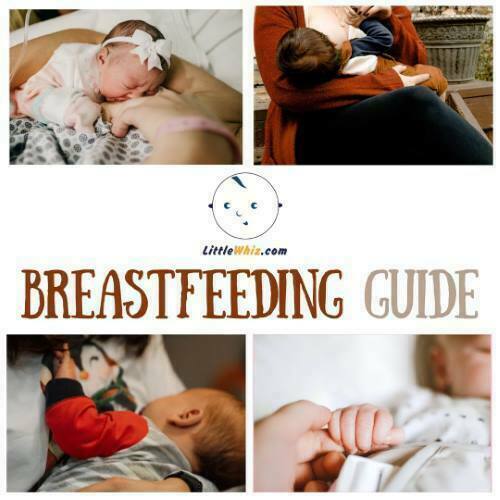You’ve made the right decision to breastfeed your baby. This is good news for you and your baby. Breastfeeding your baby is a great way to give your baby the best start in life. Mother’s milk is the best food possible for newborns. It contains all the nutrients your baby needs and also has special properties that protect it from illness.
This article is packed with information that a new mom needs to know about breastfeeding her baby.
What is Breastfeeding?
Breastfeeding is also known as breastfeeding or chestfeeding. It involves the act of giving milk to an infant from her breasts or pumping it from the breast and then bottle-feeding it to the infant.
It’s good to know that breastmilk comes in three stages. Nature is perfect for your baby’s age. This makes it the ideal food from the start. These three stages are called Colostrum, Transitional, and Mature milk.
Colostrum: The milk will not have arrived right after you give birth. Instead, you will be producing a thick yellowish (sometimes clear) substance from your breasts that likely leaked during pregnancy. Colostrum is the substance you are producing. Colostrum is a vital mixture of vitamins, minerals, and protein that helps protect your baby from harmful bacteria and viruses. It stimulates the production of antibodies in your baby’s body. This substance is applied to the inside of your baby’s intestines and protects their developing immune system. It stimulates your baby’s first bowel movements and reduces the chance of jaundice.
Although new mothers are likely to make very little colostrum, your baby will not need more than a teaspoon per meal in the early years. Sucking from the beginning can stimulate the body to produce the next stage in her milk production.
Transitional milk: This is the milk that’s produced after the third or fourth day. It looks a lot like orange juice mixed with milk. Although it may not be very appealing to us, it will taste much better for your baby. This is when your milk comes in for the first time. It contains less protein and immunoglobulins than your colostrum, but more calories, fat, and lactose. New mothers don’t need to worry about how much milk they produce for their babies at this stage. Their stomach is small enough that they can eat a handful of walnuts.
Mature milk: This is the last stage of a mother’s milk. It can arrive between 10 and 2 weeks after birth. Mature milk is typically thin and white, but can occasionally be slightly bluish. This milk contains all the nutrients, fats, and vitamins a baby needs.
What Is The Benefits of Breastfeeding?
There are many benefits to breastfeeding your baby. Breast milk is rich in antibodies that can help your baby fight off diseases. Lung infections, ear infections, and respiratory diseases such as pneumonia. It provides your baby the nutrition it needs, and rarely causes allergies.
Breastmilk is easier to digest for babies and less likely to have diarrhea. It’s convenient and free! It doesn’t have to be made and it is always available for your baby.
Breastfeeding is good for babies and mothers. Breastfeeding helps the uterus to return to pre-pregnancy status quicker. Breastfeeding also builds bone strength, which protects mothers from bone fractures in old age. Breastfeeding mothers burn calories and help them return to pre-pregnancy states faster.
How Long Usually Should A Mother Breastfeed Their Baby?
Some people believe that shorter feeds are better than longer to avoid soreness and cracking. However, this is not the truth. This is usually not due to feeding too much, but from being in a poor position while feeding.
Sessions can last anywhere from 20-30 minutes, but this is an average session and each baby is unique. Your baby’s growth may mean that they take longer or shorter sessions.
Wait for your baby to stop feeding. They will usually let go of the nipple. You should be alert for signs such as a slowing of their sucking pattern to four per swallow.
How Often Should A Mother Continue To Breastfeed?
Most newborns are not hungry, and they will usually start to eat around the third day. There won’t be much demand for breast milk initially. Mothers who are new may need to start the first push and feed their babies.
Even if they aren’t hungry for breast milk yet, a newborn should be fed between eight and twelve times per day. On average, feeding should take place every 2 to 3 hours during the day.
Your baby’s feeding schedule will change over the first few weeks. Babies will need to be fed more or less often by new mothers. New mothers may need to feed their babies every one to two hours if they have impatient or hungry babies. A baby who is more satisfied can go for up to three to four hours with no feeding. It’s temporary for new mothers who feel like they have to feed their babies constantly. As your baby grows, and you produce more milk from breastmilk, the time between feedings will get longer.
It’s a good thing to know that friends who feed their babies formulas don’t often give their babies breast milk. Breast milk is easier to digest than formulas, which will make their stomachs empty quicker and increase their thirst for breastmilk sooner.
How Can I Increase My Breast Milk?
Your body will release hormones when your baby sucks on your breast. These hormones ‘trigger’ your breast to produce milk. This is known as the “letdown” reflex. It occurs when your breast muscles contract and move milk through your breasts ducts. Your breasts will produce more milk the more you feed them.
Pumping your breasts between meals is a good tip. It can increase milk production and help mothers who are new to the world. It can make it easier to pump by warming your breasts before you do.
Another alternative is to eat lactation cookies. These cookies are easy to make and readily available. These cookies contain ingredients that can be used to aid in new mother’s milk production.
If you are looking for a breast pump to help you do the pumping process, you can check out Top 7 Breast Pump 2020 in Malaysia
Want to increase breast milk? Check out some of the breast milk booster cookies at our store. It is really popular for mothers these days and very delicious. You will feel that you are eating normal cookies only.
Tips And Techniques For Breastfeeding
It may take some time to get your baby in the right place for feeding at first. An improper latch is the leading cause of breast discomfort. Your baby should cover his or her mouth when you are feeding him. This is to ensure that the milk glands of their milk glands get massaged by your baby’s lips, tongue, and mouth. Many people believe that babies just sucking the milk out. However, your baby will not be able to digest the milk because its glands won’t secrete it. This will cause your baby to become hungry and may also cause soreness or crackling in your nipples.
Looking for a reputable nipple cream for crack nipple or to soothe your nipple when breastfeeding your baby? Visit here for those who could help you.
Earth Mama Angel Baby Natural Nipple Butter
Pigeon Nipple Care Cream
Lansinoh HPA Lanolin Nipple Cream
Joille Mama Nipple Balm
Contact us today which one would suits you better or more popular among the mothers.
Your baby should lie on your breast with its front-facing you, and touch your stomach to your stomach. To make swallowing easier, their head should be aligned with the rest. To encourage your baby to open his mouth, you can tickle their lips with your nipple. This will make it easier to swallow. To get your baby used to the idea of milk and colostrum, you can try this.
Instead of pressing your breasts into your baby’s mouth, let them take initiative and bring you towards your breast. Your baby should be able to grasp your breast and sucking in their mouth well before you let go.
If your baby’s chin touches your breast, it is a good sign that they have a secure latch. Instead of being tucked in, their lips will appear to be flanged like fish lips. They should not be sucking on their lower lips or tongues. Soon you will notice a steady, strong suck swallow pattern. The sound of swallowing and gulping will follow.
Once you have delivered, it will be very beneficial to learn how to properly breastfeed your baby. There are many classes that teach breastfeeding. They also have tips for how to increase your milk supply. If you have decided to breastfeed, taking the initiative to learn more about it will give you an advantage.
It is helpful to feed your baby in a calm and peaceful place until you feel comfortable. This will help you focus on the feedings. Be comfortable. Be comfortable, whether you’re on the couch or in bed. Placing a pillow on your lap while you are sitting up can help raise your baby to a higher position. It also helps prevent pressure from your incisions if you have had a cesarean. Practice makes perfect! It may take some practice to master the skill, but you will soon be an expert.
During feeding, switch sides. If your baby isn’t nursing or hasn’t completely drained, you should start each feeding on the breast. You can also prevent leakage by tucking a tissue or nursing pad into your bra. The amount of milk produced is greatly affected by how often and how intensely you feed your baby, especially in the first few weeks. It is important to not reduce the milk demand or cut the sessions short. This can have a huge impact on the supply of milk.
If you’re not able to properly nurse your baby the first time, don’t get too discouraged. You and your baby are both beginners (even though this may not be your first baby). Both mother and baby need to learn a lot before they can be at ease. Even if you feel overwhelmed after giving birth, it is important to keep your cool. Tension and stress can affect your milk production
Positions of mother and baby during breastfeeding
Each mother and baby have different needs, so you may need to try something new. Try different techniques and find the one that works best for you and your child. A rolled towel under your breast can help you and your baby latch on more easily. As your baby grows, your methods and techniques will likely change. It is important to adapt to new ways to help both mom and baby.
Breastfeeding can be done in many ways. Here are the most popular:
Position laid-back
This is a relaxed position in which your baby rests on you and your neck, shoulders, and the head is supported. This position is popular for newborns who are just beginning to breastfeed. This position is very comfortable for both mother and baby. It also allows the baby to take in breastmilk easily and deeply. You can do this in bed or on the sofa. Just make sure you can lean back enough to allow your baby to rest fully on your body. As your baby is supported completely by your body, mothers don’t have to lift them up.
Football Holds The Future
This position is also beneficial for mothers as it helps babies latch onto the breasts. This position is great for breastfeeding if you have had a C section. To support your baby while you are holding him, you will need several pillows to rest your head-on. As you hold your baby, place your arm on the pillow on either side. Your forearm will support your baby’s back and neck while your hand supports their neck. As if you were carrying a football, tuck your baby’s legs under your arm.
Cross-cradle Holding
For those babies who have difficulty latching on, this position is often a good choice. You will be supporting your baby with pillows so that you don’t have to bend. Your baby should be supported with one arm raised on a pillow and the other in a semi-upright position. While holding your baby with your opposite arm, support their neck and head with the other hand. To support your breast, place your hand on the breast that you are currently feeding on. You will then position your baby’s nose towards you by placing the hand on top of your breast. Your baby’s ear should meet your nipple.
Side-lying
Side-lying is a great choice for women who have recently had a C-section, or for active babies that want to avoid the incision. You can now lie down with your baby in front of you, tummy to stomach. Use pillows to give your baby the back support he or she will require. Switching breasts is possible by placing your baby on your chest and then rolling onto your back.
Hold Onto Your Cradle
After your baby is able to breastfeed properly, the cradle-hold method is recommended. A chair with an armrest is best, as well as pillows to raise your baby up to breast height. You can either use pillows under your feet, or a stool to ensure your knees meet your hips. Place your baby on your chest and face your baby with your arms.
What Foods Should A Mother Avoid While Breastfeeding?
It is crucial to know what you eat after giving birth, especially during the first two to three weeks of your milk production. It is crucial to not eat a restrictive diet and to eat a balanced diet that includes all food groups.
Choose unsaturated fats, oils, and butter over trans fat. Avoid sweetened and salty foods and eat more nutrient-rich food. Breastfeeding mothers will need to consume at least four servings of dairy daily in order to increase their milk production.
Once a mother’s milk production begins, they must consume at least 1,800 calories per day. A diet lower than this will result in low milk supply and fatigue.
This guide to breastfeeding is hoped to help new and experienced mothers as well as those who are just starting out with breastfeeding. Check out our other articles to find tips, tricks, and information on everything parenthood and confinement.




